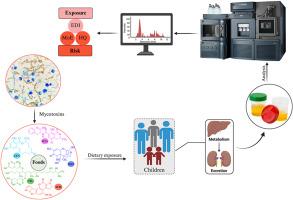巴西圣保罗儿童暴露于真菌毒素和使用尿液生物标志物的风险表征
IF 7.3
2区 环境科学与生态学
Q1 ENVIRONMENTAL SCIENCES
引用次数: 0
摘要
本研究通过分析尿液样本中的霉菌毒素生物标志物,评估了巴西圣保罗本文章由计算机程序翻译,如有差异,请以英文原文为准。


Children's exposure to mycotoxins and risk characterization using urinary biomarkers in São Paulo, Brazil
This study assessed mycotoxin exposure of preschoolers (3–6 years, n = 26), schoolers (7–10 years, n = 29), and adolescents (11–17 years, n = 49) from São Paulo, Brazil, by analyzing mycotoxin biomarkers in urine samples. Analyses were performed using ultra-performance liquid chromatography coupled to tandem mass spectrometry (UPLC-MS/MS), for determination of aflatoxin M1 (AFM1), ochratoxin A (OTA), fumonisins B1 (FB1) and B2 (FB2), deoxynivalenol (DON), T-2 and HT-2 toxins, zearalenone (ZEN) and its metabolites α- and β-zearalenol (ZEL). Urinary ZEN and its metabolites (α- and β-ZEL) were the most frequently detected biomarkers, followed by FBs (FB1+FB2), DON, and OTA. Co-exposure to 2–6 mycotoxins was observed in 63 % of samples, most prominently among schoolers (69 %), followed by adolescents (63 %) and preschoolers (61 %). Estimated daily intake (EDI) values were calculated under lower (LB), middle (MB), and upper bound (UB) scenarios. Several 95th percentile UB-EDI values exceeded maximum level (ML) or tolerable daily intake (TDI) limits, particularly for preschoolers regarding exposure to AFM1 (EDI: 0.786 μg/kg body weight (bw)/day), FBs (EDI: 5.22 μg/kg bw/day), OTA (EDI: 0.683 μg/kg bw/day) and the sum of ZEN, α- and β-ZEL (ZENeq) (0.92 μg/kg bw/day). Under the UB scenario, hazard quotient (HQ) values > 1 were found for OTA in 100 % of preschoolers (median: 1.71) and schoolers (1.4), and ZENeq in about 77 % of preschoolers (median: 1.14). Margin of exposure (MoE) values for AFM1 were <10,000 across all age groups, indicating potential carcinogenic concern. These results underscore substantial real-life co-exposure to multiple mycotoxins in children in Brazil, reinforcing the need for age-specific surveillance and risk management strategies. The detection of multiple toxins above safety thresholds highlights the vulnerability of this population and the importance of strengthened food safety policies.
求助全文
通过发布文献求助,成功后即可免费获取论文全文。
去求助
来源期刊

Environmental Pollution
环境科学-环境科学
CiteScore
16.00
自引率
6.70%
发文量
2082
审稿时长
2.9 months
期刊介绍:
Environmental Pollution is an international peer-reviewed journal that publishes high-quality research papers and review articles covering all aspects of environmental pollution and its impacts on ecosystems and human health.
Subject areas include, but are not limited to:
• Sources and occurrences of pollutants that are clearly defined and measured in environmental compartments, food and food-related items, and human bodies;
• Interlinks between contaminant exposure and biological, ecological, and human health effects, including those of climate change;
• Contaminants of emerging concerns (including but not limited to antibiotic resistant microorganisms or genes, microplastics/nanoplastics, electronic wastes, light, and noise) and/or their biological, ecological, or human health effects;
• Laboratory and field studies on the remediation/mitigation of environmental pollution via new techniques and with clear links to biological, ecological, or human health effects;
• Modeling of pollution processes, patterns, or trends that is of clear environmental and/or human health interest;
• New techniques that measure and examine environmental occurrences, transport, behavior, and effects of pollutants within the environment or the laboratory, provided that they can be clearly used to address problems within regional or global environmental compartments.
 求助内容:
求助内容: 应助结果提醒方式:
应助结果提醒方式:


